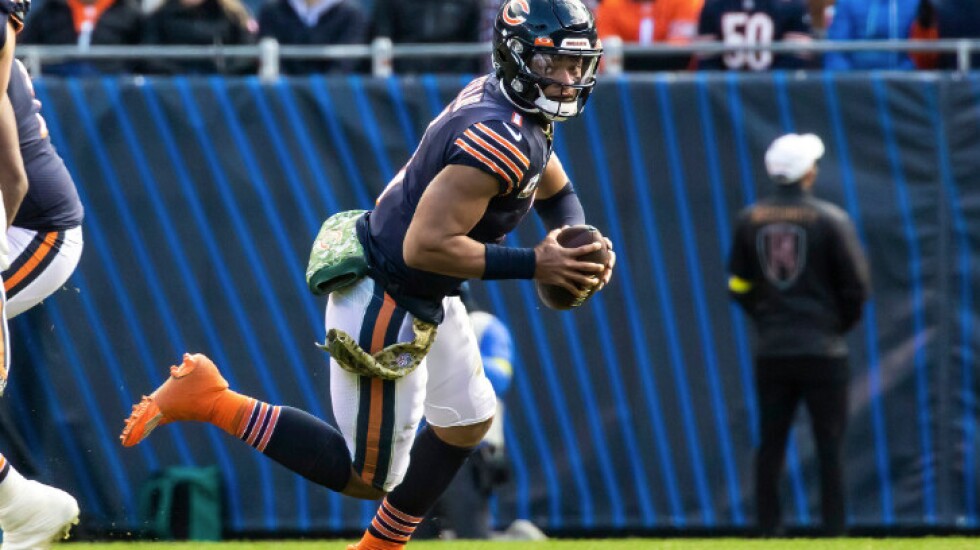
An evolution is happening in the NFL — and the Bears are ahead of the curve.
Look at the quarterbacks who started games in Week 10: Most teams have a dual-threat talent leading their offense. The scale slides from the elusive tornado of Kyler Murray to the SUV with an arm that is Josh Allen. Justin Fields has shown the last month that he belongs in this new, exciting era with his own style. More on him in a minute . . . first a little history.
When Alex Smith was drafted No. 1 overall in 2005, it was a warning that spread offenses were here to stay in one form or another. What started with undersized, overmatched high school teams, now had a home in the NFL. Alas, there were coaches and pundits who felt that using your quarterback in the run game was a fool’s errand. Defenses were too good and too fast to be manipulated by a gimmicky scheme and shifty quarterback.
There were outliers such as Michael Vick, but his success was dismissed as a function of God-given talent. There are still those who challenge Vick’s greatness because he was incomplete as a passer, but evolution takes time.
While quarterback run schemes were filtering their way up to the NFL, star power was filtering its way down to the high school and college game. Smart coaches stopped taking their best athletes and converting them into wide receivers and cornerbacks. If you have an extremely talented individual, why wouldn’t you want them to have the ball on every offensive snap? The smartest coaches recognized that talent early and added pass-game elements to immense athletic ability. Results were magical.
That’s where we’re at now. Players such as Dak Prescott, Jalen Hurts and Fields had prep careers in which it would be absurd to not play them at quarterback. And, yeah, they don’t quite look the part. They weren’t what we were used to, but that’s on us. As a football public, we weren’t paying enough attention to the lower levels of the game. The changes were all around us.
To be clear, it’s not bad to have an elite pocket passer, but those guys are hard to find. We’ve been spoiled by 25 years of watching Drew Brees, Peyton Manning and Tom Brady orchestrate winning football from the pocket. It’s still possible to win this way. Matthew Stafford’s Super Bowl win stands as evidence of that, but look around.
Quarterbacks who can run have added value. It’s clear Fields wants the best of both worlds, and Bears fans should, too. Over the last month of games, Fields’ ability to run continues to put defenders in conflict. If he’s able to marry what he’s doing on the ground to his potential as a passer, he could be unstoppable.
Steve Young was one of the old-school dual-threat quarterbacks. He has been paying close attention to how the game is evolving. Last week, he discussed Fields on ESPN’s “Pardon the Interruption.” He made this plea for what happens next:
“In the pros, if you’re going to be a dual-threat quarterback, you need to be a sophisticated passer who can run. We know that Justin and I and all of us like us, we already know how to run. Don’t need to be coached. With sophisticated passing, we need to have gurus that understand dual-threat quarterback talent, then teach them how to throw the football. We’re getting that infrastructure more and more.”
Let’s stop for a minute and acknowledge that it’s very exciting that Young sees himself in Fields.
Beyond that, he makes an excellent point about coaching. Like fans, organizations need to be forward-thinking. Almost no quarterback is a finished product coming out of college. Make sure that as more dual-threat quarterbacks make it to the pros, you have a coaching staff that isn’t hell-bent on turning them into something they’re not. So far, Matt Eberflus and Luke Getsy have done a good job in that regard.
Their reward has been a quarterback who keeps breaking records while he figures it out. In Chicago, the evolution is televised, and we’re all watching.
You can hear Laurence Holmes talk Chicago sports Monday to Friday from 10 a.m.-2 p.m. on 670 The Score with Dan Bernstein.







